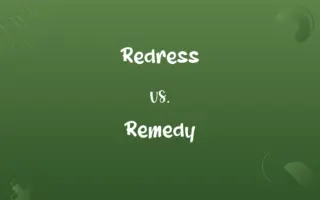Motif vs. Motive: Know the Difference

By Shumaila Saeed & Dua Fatima || Updated on March 3, 2024
A motif is a recurring element in art or literature, while a motive is a reason for doing something.

Key Differences
A motif in literature, art, or music refers to a recurring theme, symbol, or element that has significance to the story or piece. It often symbolizes a critical aspect of the narrative or theme, providing depth and enhancing the audience's understanding. On the other hand, a motive is the driving force or reason behind an individual's actions or behavior, often explored in psychological, criminal, or literary analysis to explain why characters behave in certain ways.
Shumaila Saeed
Mar 03, 2024
Motifs are used to reinforce and enrich the narrative or thematic structure of a creative work, motives delve into the psychological aspects of characters, offering insights into their desires, fears, or ethical convictions. Motifs can appear as visual elements, phrases, or structural patterns, contributing to the work's atmosphere and thematic coherence. In contrast, motives are deeply tied to character development and plot progression, often serving as a key factor in unraveling mysteries or understanding character motivations.
Dua Fatima
Mar 03, 2024
Motifs are often symbolic, carrying meanings that transcend their literal appearance in the work. They can be used to suggest themes, moods, or various other aspects of the work without direct statement. Motives, however, are explicitly connected to the goals or psychological states of characters, providing a basis for understanding their decisions and actions within the narrative.
Shumaila Saeed
Mar 03, 2024
In analyzing literature or art, identifying motifs can reveal the underlying messages or themes the creator wishes to convey, as they are intentionally repeated to invoke reflection or emotional response. Whereas, analyzing motives requires a look into the backstory, personality, or circumstances influencing a character's decisions, highlighting the complexities of human behavior and ethics.
Shumaila Saeed
Mar 03, 2024
Motifs and motives, though different in their application and purpose, both play crucial roles in adding layers of meaning to creative works. While motifs enrich the narrative or thematic fabric, motives offer a window into the inner workings of characters, both serving to deepen the audience's engagement and understanding of the work.
Shumaila Saeed
Mar 03, 2024
ADVERTISEMENT
Comparison Chart
Definition
Recurring theme, symbol, or element
Reason behind an action or behavior
Shumaila Saeed
Mar 03, 2024
Examples
Repeated imagery of darkness in a novel
A character's revenge for betrayal
Dua Fatima
Mar 03, 2024
Symbolism
Often symbolic, adding deeper meaning
Directly tied to character's goals
Shumaila Saeed
Mar 03, 2024
ADVERTISEMENT
Motif and Motive Definitions
Motif
Recurring element.
The motif of water in the novel symbolizes renewal.
Shumaila Saeed
Mar 03, 2024
Motif
Structural pattern.
The motif of three in fairy tales often signifies a trial and triumph.
Shumaila Saeed
Mar 03, 2024
Motive
Ethical conviction.
A sense of justice served as the detective's motive.
Shumaila Saeed
Mar 03, 2024
Motif
Visual symbol.
The motif of birds throughout the film symbolized freedom.
Hifza Nasir
Mar 03, 2024
ADVERTISEMENT
Motif
Symbolic theme.
The green light is a recurring motif in The Great Gatsby, representing unattainable dreams.
Shumaila Saeed
Mar 03, 2024
Motif
Literary device.
Shakespeare often used the motif of mistaken identity for comedic effect.
Dua Fatima
Mar 03, 2024
Motive
Goal-oriented reason.
Her motive for studying hard was to get into a good university.
Dua Fatima
Mar 03, 2024
Motif
A recurring or dominant element; an artistic theme.
See how the artist repeats the scroll motif throughout the work?
Shumaila Saeed
Oct 19, 2023
Motive
An emotion, desire, physiological need, or similar impulse that acts as an incitement to action.
Shumaila Saeed
Oct 19, 2023
Motive
(obsolete) An idea or communication that makes one want to act, especially from spiritual sources; a divine prompting.
Shumaila Saeed
Oct 19, 2023
Motive
The theme or subject; a leading phrase or passage which is reproduced and varied through the course of a comor a movement; a short figure, or melodic germ, out of which a whole movement is develpoed. See also Leading motive, under Leading.
Shumaila Saeed
Oct 19, 2023
Motif
(Music) A short rhythmic or melodic passage that is repeated or evoked in various parts of a composition.
Shumaila Saeed
Oct 19, 2023
Motive
Causing motion; having power to move, or tending to move; as, a motive argument; motive power.
Shumaila Saeed
Oct 19, 2023
Motif
A unifying idea that is a recurrent element in a literary or artistic work;
It was the usual `boy gets girl' theme
Shumaila Saeed
Oct 19, 2023
Repeatedly Asked Queries
Can a motif be a symbol?
Yes, motifs often serve as symbols, carrying deeper meanings beyond their literal appearance in the work.
Shumaila Saeed
Mar 03, 2024
Is a motif only found in literature?
No, motifs can be found in literature, art, and music, serving to enhance the thematic or atmospheric aspects of the work.
Dua Fatima
Mar 03, 2024
How does a motive differ from a motif?
A motive is the reason behind an action or behavior, while a motif is a recurring element that enriches the narrative or thematic content.
Dua Fatima
Mar 03, 2024
What role does a motive play in character analysis?
A motive provides insight into a character's decisions and actions, revealing their psychological state or ethical convictions.
Hifza Nasir
Mar 03, 2024
Can motives be analyzed in art?
While motives are primarily associated with actions and behaviors in literature and psychology, the concept can be applied to the motivations behind artistic creation.
Shumaila Saeed
Mar 03, 2024
What is a motif in literature?
A motif is a recurring theme, symbol, or element that emphasizes the narrative or thematic aspects of the literature.
Dua Fatima
Mar 03, 2024
How does identifying motifs benefit the understanding of a work?
Identifying motifs helps uncover underlying messages or themes, enhancing the audience's appreciation and interpretation of the work.
Shumaila Saeed
Mar 03, 2024
What makes a motive significant in storytelling?
Motives are significant because they provide depth to characters, making their actions more understandable and relatable.
Shumaila Saeed
Mar 03, 2024
Can the same element be both a motif and a motive?
While unusual, an element could serve as a motif in its repetition and symbolic meaning, and as a motive if it directly influences a character's actions.
Hifza Nasir
Mar 03, 2024
How do motifs contribute to the atmosphere of a work?
Motifs contribute to the atmosphere by repeatedly invoking certain feelings or moods through their symbolic presence.
Dua Fatima
Mar 03, 2024
Share this page
Link for your blog / website
HTML
Link to share via messenger
About Author
Written by
Shumaila SaeedShumaila Saeed, an expert content creator with 6 years of experience, specializes in distilling complex topics into easily digestible comparisons, shining a light on the nuances that both inform and educate readers with clarity and accuracy.
Co-written by
Dua Fatima







































































